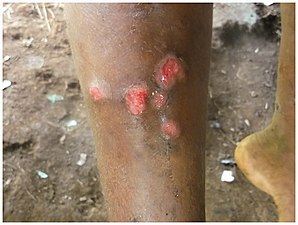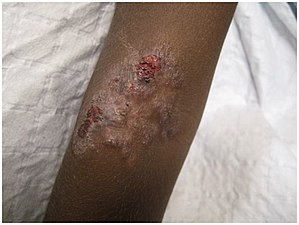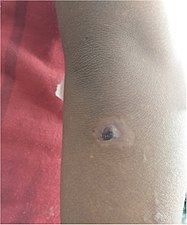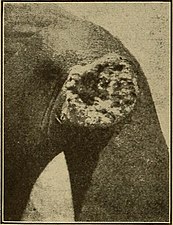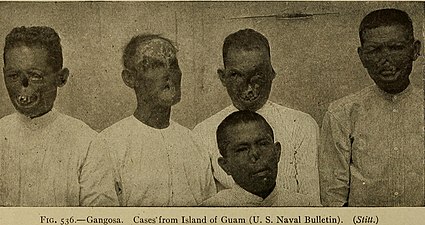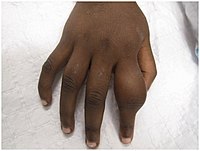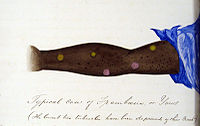Yaws
| Yaws | |
|---|---|
| Other names | Frambesia tropica, thymosis, polypapilloma tropicum, Infectious disease |
| Symptoms | Hard swelling of the skin, ulcer, joint and bone pain[6] |
| Causes | Treponema pallidum pertenue spread by direct contact |
| Diagnostic method | Based on symptoms, blood antibody tests, polymerase chain reaction |
| Prevention | Mass treatment |
| Medication | Azithromycin, benzathine penicillin |
| Frequency | 46,000–500,000[7] |
Yaws is a tropical
Yaws is spread by direct contact with the fluid from a lesion of an infected person. The contact is usually of a nonsexual nature. The disease is most common among children, who spread it by playing together.
No vaccine has yet been found.[8] Prevention is, in part, done by curing those who have the disease, thereby decreasing the risk of transmission. Where the disease is common, treating the entire community is effective. Improving cleanliness and sanitation also decreases spread. Treatment is typically with antibiotics, including azithromycin by mouth or benzathine penicillin by injection. Without treatment, physical deformities occur in 10% of cases.
Yaws is common in at least 13
Signs and symptoms
Yaws primarily occurs in children, most frequently in those aged 6–10.[10]
Yaws is classified as primary, secondary, and tertiary; this can be clinically useful, but infected patients often have a mix of stages.[2]
, a painless but distinctive "mother yaw"
-
Papilloma mother yaw
-
Mother yaw nodule with central ulceration and a yellow crust
-
Ulcerated mother yaw
-
Ulcerated mother yaw
-
Healed primary yaw lesion, showing pigmented scar
The secondary stage occurs months to two years later (but usually 1–2 months later), and may thus begin when the mother yaw has not yet healed.
Secondary yaws typically shows widespread skin lesions that vary in appearance, including "crab yaws" (areas of skin of abnormal color) on the palms of the hands and soles of the feet[13] (named for the crab-like gait they cause people with painful soles to assume[2]). These may show desquamation.[citation needed] These secondary lesions frequently ulcerate and are then highly infectious, but heal after 6 months or more.[citation needed]
Secondary yaws affects the skin and bones.[13] The most common bone-related problem is periostitis, an inflammation around the bone, often occurs in the bones of the fingers and the long bones of the lower arms and legs, causing swollen fingers and limbs.[13] This causes pain at night and thickening of the affected bones (periostitis).[2] About 75% of infected children surveyed in Papua New Guinea reported joint pain.[2] Swollen lymph nodes, fever, and malaise are also common.[13]
After primary and secondary yaws (and possibly, in some cases, without these phases), a latent infection develops.[2] Within five years (rarely, within ten years[2]) it can relapse and become active again, causing further secondary lesions, which may infect others.[13] These relapse lesions are most commonly found around the armpits, mouth, and anus.[2]
-
Secondary yaws begin as multiple small lesions.
-
The small lesions grow.
-
Secondary lesions vary in appearance (see list of terms)
-
Here two different appearances (papulosquamous plaque and yellow-crusted nodules) are seen in the same 10-year-old (large-scale of both, close-up of nodules)
-
Hypopigmentation and an crusted erosion, elbow of a 5-year-old
-
Secondary yaws;hypopigmented areas of skin topped with pink and brown papules, 9-year-old
-
Erosion on the sole of the foot, close-up (large-scale). If deeper, it would be an ulcer
-
Secondary yaws papilloma (same 9-year-old as pictures of feet)
-
Secondary breakout in a 12-year-old Javanese child (wax model)
-
Secondary yaws scars in an adult with childhood history of yaws
An estimated 10% of people with yaws formerly were thought to develop tertiary disease symptoms, but more recently, tertiary yaws has been less frequently reported.[13][2]
Tertiary yaws can include gummatous nodules. It most commonly affects the skin. The skin of the palms and soles may thicken (hyperkeratosis). Nodules ulcerating near joints can cause tissue death. Periostitis can be much more severe. The shinbones may become bowed (saber shin)[13] from chronic periostitis.[2]
Yaws may or may not have
Rhinopharyngitis mutilans
Rhinopharyngitis mutilans,
-
Deep ulceration occurs in tertiary yaws
-
Severe tertiary yaws; gangosa
-
Goundu, a very rare yaws-caused deformity around the nose
Cause
Yaws is caused by infection with bacteria of the Treponema pallidum subspecies pertenue.[10] The initial yaws wound contains infectious bacteria, which are passed onto others through skin-to-skin contact, typically during play or other normal childhood interactions.[10][17] Early (primary and secondary) yaws lesions have a higher bacterial load, thus are more infectious.[2] Both papillomas and ulcers are infectious.[10] Infectivity is thought to last 12–18 months after infection, longer if a relapse occurs. Early yaws lesions are often itchy, and more lesions may form along lines that are scratched. Yaws may be evolving less conspicuous lesions.[2] After a new person is infected, an infectious papilloma will form within 9–90 days (on average 21 days).[10]
T. pallidum pertenue has been identified in nonhuman
Diagnosis
Most often the diagnosis is made clinically.
A microscopic examination of a biopsy of a yaw may show skin with clear
Serological tests cannot distinguish yaws from the closely related syphilis;[2] no test distinguishing yaws from syphilis is widely available. The two genomes differ by about 0.2%. PCR and DNA sequencing can distinguish the two.[2] There are also no common blood tests which distinguish among the four treponematoses: syphilis (Treponema pallidum pallidum), yaws (Treponema pallidum pertenue), bejel (Treponema pallidum endemicum), and pinta (Treponema carateum).[18]
Haemophilus ducreyi infections can cause skin conditions that mimic primary yaws. People infected with Haemophilus ducreyi lesions may or may not also have latent yaws, and thus may or may not test positive on serological tests. This was discovered in the mid-2010s.[13] It seems that a recently diverged strain of Haemophilus ducreyi has evolved from being a sexually transmitted infection to being a skin ulcer pathogen that looks like yaws.[19]
Yaws has been reported in nonendemic countries.[2]
Treatment
Treatment is normally by a single
The historical strategy for the eradication of yaws (1952–1964) was:[13]
| Prevalence of clinically active yaws | Treatment strategy |
|---|---|
| Hyperendemic: above 10% | Benzathine benzylpenicillin to the whole community
(total mass treatment) |
| Mesoendemic: 5–10% | Treat all active cases, all children under 15 and all contacts of infectious cases
(juvenile mass treatment) |
| Hypoendemic: under 5% | Treat all active cases and all household and other contacts
(selective mass treatment) |
Benzathine benzylpenicillin requires a cold chain and staff who can inject it, and there is a small risk of anaphylaxis. It was also not reliably available during the 2010s; there have been supply shortages.[13]
In the 2010s, a single oral dose of
Within 8–10 hours of penicillin treatment, bacteria can no longer be found in lesion biopsies.[2] Primary and secondary lesions usually heal in 2–4 weeks; bone pain may improve within two days.[13] If treated early enough, bone deformities may reverse and heal.[2] Primary and secondary stage lesions may heal completely, but the destructive changes of tertiary yaws are largely irreversible.[citation needed]
If lesions do not heal, or RPR test results do not improve, this may indicate treatment failure or re-infection; the treatment is typically repeated.[2] WHO guidelines says that any presumed treatment failures at 4 weeks require macrolide resistance testing.[10]
-
Secondary yaws in the left armpit of a ten-year-old, 2020
-
Same person, 2 weeks and 3.5 months after a single-dose azithromycin
-
Before and two weeks after a single injection of benzathine penicillin, 1950s.
Epidemiology

Where the road ends, yaws begins
—WHO saying, quoted by Kingsley Asiedu.[22]
Yaws is typically found in humid tropical[13] forest regions in South America, Africa, Asia and Oceania.[8][10]
Yaws primarily affects children, with up to 80% of cases in those under 15 years of age, and peak incidence in children aged six to ten.[10] Boys and girls are impacted equally.[10]
It is more common in remote areas, where access to treatment is poorer.[13] It is associated with poverty and poor sanitation facilities and personal hygiene.[8][23][10]
Worldwide, almost 85% of yaws cases are in Ghana, Papua New Guinea, and the Solomon Islands. Rates in sub-Saharan Africa are low, but tend to be concentrated in specific populations. As of 2015[update], it is estimated that about 89 million people live in yaws-endemic areas, but data are poor, and this is likely an over-estimate.[23]
In the early 1900s, yaws was very common; in sub-saharan Africa, it was more frequently treated than malaria, sometimes making up more than half of treatments.[8]
Mass treatment campaigns in the 1950s reduced the worldwide
From 2008 to 2012, 13 countries reported over 300,000 new cases to the WHO. There was no system for certifying local elimination of yaws, and it is not known whether the lack of reports from some countries is because they stopped having yaws cases or because they stopped reporting them. It is estimated that if there is not an active surveillance programme, there is less than a 1-in-2 chance that a country will successfully report yaws cases (if it gets them) in over three-quarters of countries with a history of yaws. These countries are thought to need international assistance to mount effective surveillance.[25]
History
Examination of remains of
The current English name is believed to be of
Towards the end of the Second World War yaws became widespread in the North of Malaya under Japanese occupation. After the country was liberated, the population was treated for yaws by injections of arsenic, of which there was a great shortage, so only those with stage 1 were treated.[26]
Eradication


A series of WHO yaws control efforts, which began shortly after creation of the WHO in 1948, succeeded in eradicating the disease locally from many countries, but have not lasted long enough to eradicate it globally. The Global Control of Treponematoses (TCP) programme by the WHO and the
In the Philippines, yaws stopped being listed as a notifiable disease in 1973; as of 2020, it is still present in the country.[3]
India implemented a successful Yaws eradication campaign that resulted in the 2016 certification by the WHO that India was free of yaws.[31][29][32] In 1996 there were 3,571 yaws cases in India; in 1997 after a serious elimination effort began the number of cases fell to 735. By 2003 the number of cases was 46. The last clinical case in India was reported in 2003 and the last latent case in 2006;[33] certification by the WHO was achieved in 2016.[31][34]
In 2012 the WHO officially targeted yaws for eradication by 2020 following the development of orally administered azithromycin as a treatment, but missed that target.[35][36][37] The Morges approach (named after Morges, Switzerland, where a meeting on it was held[38]) involved mass treatment with azithromycin. This was safe, but ran into problems with antibiotic resistance, and did not fully interrupt transmission.[13]
The discovery that oral antibiotic azithromycin can be used instead of the previous standard, injected penicillin, was tested on Lihir Island from 2013 to 2014;[39] a single oral dose of the macrolide antibiotic reduced disease prevalence from 2.4% to 0.3% at 12 months.[40] The WHO now recommends both treatment courses (oral azithromycin and injected penicillin), with oral azithromycin being the preferred treatment.[10]
As of 2020[update], there were 15 countries known to be endemic for yaws, with the recent discovery of endemic transmission in Liberia and the Philippines.[41] In 2020, 82,564 cases of yaws were reported to the WHO, and 153 cases were confirmed. The majority of the cases are reported from Papua New Guinea and with over 80% of all cases coming from one of three countries in the 2010–2013 period: Papua New Guinea, Solomon Islands, and Ghana.[41][42] A WHO meeting report in 2018 estimated the total cost of elimination to be US$175 million (excluding Indonesia).[43]
In the South-East Asian Regional Office of the WHO, regional eradication efforts are focused on the remaining endemic countries in this region (Indonesia and East Timor)[44][45] after India was declared free of yaws in 2016.[46][43]
Although yaws is highly localized and eradication may be feasible, humans may not be the only reservoir of infection.[24]
References
- PMID 30252269.
- ^ PMID 25193248.
- ^ PMID 31996251.
- ISBN 978-1-4160-2999-1.
- OCLC 62736861.
- ^ S2CID 208791874.
- ^ from the original on 18 May 2014.
- ^ PMID 25193248.
- PMID 26001576.
- ^ a b c d e f g h i j k l m n o "Yaws". World Health Organization. 12 January 2023. Retrieved 24 May 2024.
- ^ Charlevoix PF (1730). Histoire de l'isle Espagnole ou de S. Domingue. Paris: F. Barois. p. 29.
- ^ "Number of cases of yaws reported". World Health Organization Global Health Observatory. Retrieved 13 February 2019.
- ^ PMID 30274488.
- PMID 30441754.
- .
- ISBN 9781498805742. Retrieved 31 October 2015.
- ^ Hotez 2022, p. 218.
- ^ a b c d Davis CP, Stoppler MC. "Yaws". MedicineNet.com. Archived from the original on 8 October 2012. Retrieved 5 August 2012.
- S2CID 1699547.
- S2CID 17517869.
- ^ "Countries where yaws is endemic". Our World in Data. Retrieved 17 June 2024.
- ^ PMID 18670660.
- ^ PMID 26001576.
- ^ PMID 22235208.
- PMID 30513075.
- ^ "All things uncertain: The story of the G.I.S." by Phyllis Stewart Brown
- ^ a b "WHO renews efforts to achieve global eradication of yaws by 2020".
- PMID 18846236.
- ^ PMID 18670655. Archived from the originalon 21 April 2009. Retrieved 2 April 2009.
- ^ "Integrating neglected tropical diseases in global health and development". Retrieved 12 September 2017.
- ^ PMID 27654592.
- ^ "World Health Organization South-East Asia | World Health Organization" (PDF). www.who.int. Archived from the original on 8 November 2008.
- ^ Akbar S (7 August 2011). "Another milestone for India: Yaws eradication". The Asian Age. Archived from the original on 11 October 2011. Retrieved 5 August 2012.
- ^ "Yaws Eradication Programme (YEP)". NCDC, Dte. General of Health Services, Ministry of Health & Family Welfare, Government of India. Archived from the original on 2 February 2014. Retrieved 18 January 2014.
{{cite journal}}: Cite journal requires|journal=(help) - ^ "Eradication of yaws – the Morges Strategy" (pdf). Weekly Epidemiological Record. 87 (20). 2012. Archived (PDF) from the original on 8 May 2014. Retrieved 6 May 2014.
- S2CID 45958274.
- PMID 23209846.
- ^ "Summary report of a consultation on the eradication of yaws". WHO. Archived from the original on 22 April 2017.
- ^ Drug and a syphilis test offer hope of yaws eradication Archived 13 August 2013 at the Wayback Machine, Thomas Reuter Foundation, accessed 10 May 2013
- S2CID 5762563.
- ^ a b "Yaws". www.who.int.
- PMID 26001576.
- ^ hdl:10665/276314.
- PMID 18670655.
- hdl:10665/205830.
- PMID 27654592.
Works cited
- Hotez PJ (2022). "12. The Newest NTDs and a Plea to "Repair the World"". Forgotten People, Forgotten Diseases: The Neglected Tropical Diseases and Their Impact on Global Health and Development (3 ed.). John Wiley & Sons. pp. 217–226. ISBN 9781683673897.
External links
- "Treponema pallidum subsp. pertenue". NCBI Taxonomy Browser. 168.







